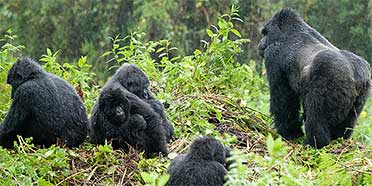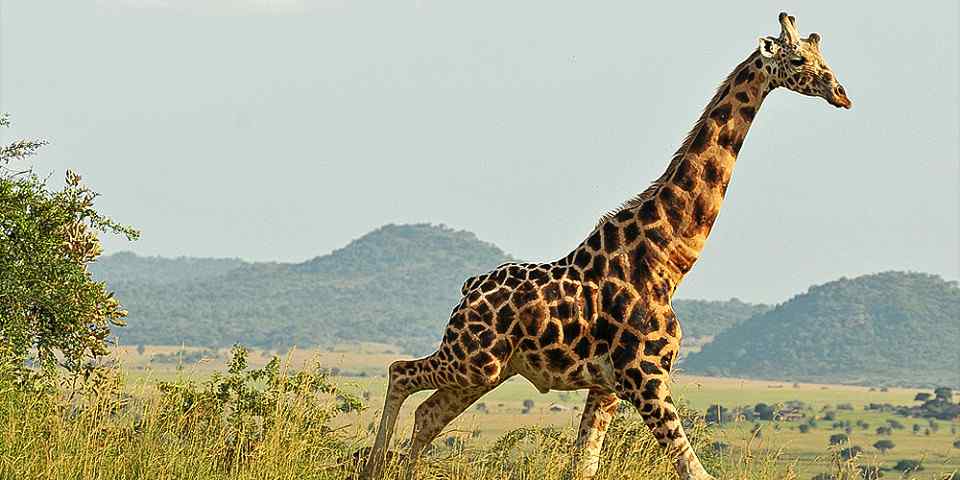
Mike is an award-winning wildlife writer, former editor of Travel Zambia magazine and author of the Bradt Guide to Southern African Wildlife.
25 people found this review helpful.
Two Worlds in One
Uganda has a modest profile among Africa’s top safari destinations. With no parks of the size or popularity of Kruger, Chobe, Serengeti or other such A-listers, its main wildlife drawcard has become the mountain gorilla. Alongside Rwanda, the country undoubtedly offers Africa’s best opportunity for close encounters with this impressive and endangered primate. Indeed, many visitors arrive just for this experience, taking the rest of their safari elsewhere.
There is no denying that a gorilla trek in the steep, damp forests of Bwindi Impenetrable National Park is one of the world’s great wildlife experiences – as is the equally thrilling chimp trekking at Kibale. However, this focus on the two great apes does not do justice to the breadth of Uganda’s appeal. Yes, the country may not offer quite the same sense of scale and spectacle as some of its larger neighbours. Small and heavily populated, it has fewer tracts of undisturbed wilderness. Yet, for its size, it is arguably the most biodiverse destination in Africa – a fact largely explained by its straddling of two very different biomes: the equatorial rainforests of the Congo Basin and the tropical savannahs of East Africa. A safari here thus offers both plains game and forest dwellers. Add to this the semi-arid country of the north, and you can end up with an amazing haul of species.
Primates are certainly a top drawcard. The two great apes were among an impressive 13 species that I saw on my most recent trip – as high a total as you might expect anywhere in the monkey-rich Amazon. Move away from the forests to the savannah reserves of Murchison Falls and Queen Elizabeth national parks, however, and you’ll also find healthy populations of elephant and buffalo, plus plentiful antelope – including hartebeest, topi and the local special, Uganda kob. Large predators, including lion, leopard and spotted hyena, occur in small numbers but are regularly seen in key locations, while Kidepo’s open grasslands in the north are also home to cheetah. On protected waterways, hippos and crocodiles are very abundant, while Mburo National Park has zebra, Murchison Falls has Rothschild’s giraffe, and little-known species such as giant forest hog and potto can also be seen, if you know where to look.
For African birders, Uganda needs little introduction and tops many a bucket list. The profusion of species, from shy rainforest rarities, including many Albertine Rift endemics, to the raptors and songbirds of the savannahs and the pageant of wetland water birds, is unrivalled. Even Entebbe Botanical Gardens can produce an excellent day’s birding, including species such as Ross’s turaco and African grey parrot that are hard to find elsewhere in East Africa. Pride of place undoubtedly goes to the huge and bizarre shoebill – relatively easily seen both at Murchison Falls and on Mabamba swamps beside Lake Victoria.
Uganda is small, no larger than the UK, which means that you can take in most of its key destinations on a single safari. The national parks are well set up for visitors, the welcome famously friendly and the standard of guiding generally excellent. Journeys on the country’s rough roads can be arduous, admittedly, and can take longer than any map might suggest. But the rewards make it well worth your while.

Dale is a multi-award-winning writer and photographer with more than 500 published magazine articles featured in magazines such as National Geographic, BBC Wildlife, Travel Africa, and CNN Travel.
24 people found this review helpful.
Uganda. More Than Just Apes.
Snow-capped mountains, swamps, steaming jungles, whitewater rivers, lakes, savannahs and woodlands – Uganda has it all.
It’s the rainforests that really attract me to this friendly and easily accessible country though. Other safari destinations have bigger parks with higher densities of wildlife, sure. But Uganda has scenic variety and it has forests – beautiful, mysterious, atmospheric, and alive with butterflies, colourful birds, towering trees, and, of course, lots and lots of primates. It’s a bit like visiting the Congo, but without actually visiting the Congo.
Chief among Uganda’s ecological highlights are undoubtedly its mountain gorillas and habituated troops of chimpanzees. Bwindi Impenetrable National Park has given me numerous life-altering experiences, chief among them, having my soul pierced by a silverback gorilla who stared into my eyes as if trying to tell me something profound. I was obviously too dull to work out what he was saying to me, but his attempt left me feeling decidedly philosophical. We are not the only intelligent beings on this earth.
Chimpanzees (the more rambunctious cousins of gorillas) can be tracked in five different reserves, but Kibale is arguably the best place to don your hiking boots and hang out with our closest counterparts on the primate tree of life.
However, it’s not only great apes that make Uganda a special destination, it’s the other 12 species of primates that live there too. It’s the 1,000-plus bird species (including the weird and wonderful shoebill), and it's the tree-climbing lions of Queen Elizabeth National Park, to name but a few.
I love the adventurous hikes in the Rwenzori Range (more romantically known as the mountains of the moon). The air up there is thin, the plants are weird, and the snow-coated peaks are not a sight one typically associates with Africa.
Traditional savannah-style game drives can be enjoyed in numerous reserves (chief among them being the Queen Elizabeth National Park), whilst Okavango-style boat excursions into Uganda’s lakes and swamps are a must for anyone keen on birds. Whilst on safari, expect to see all the usual safari stars, from leopard and lion, to elephant, hippo and buffalo. All the Big Five are present.
Uganda has long been seen as a short-stay location, a place to spend a few days trekking gorillas after a lengthier safari in Kenya or Tanzania, but there is more than enough in this relatively small and very friendly East African country to keep you occupied and happy for weeks on end.
In fact, after you’ve experienced Uganda for the first time, it’s hard not to want to keep coming back for more.

Ariadne is a renowned African wildlife photographer whose work is featured in many well-known guidebooks and magazines.
24 people found this review helpful.
Gorilla Tracking in Uganda
Uganda’s biggest attraction is mountain gorilla tracking. Seeing these gentle giants has been one of my best wildlife experiences ever. With Congo being unstable, Rwanda is the only other country where this is offered. Aside from gorillas, the forests of Uganda are a good place for seeing a wide variety of primates including the charismatic chimpanzee. Many tourists pop over to Uganda for a quick gorilla visit after their Kenya or Tanzania safari, but Uganda is a worthwhile savannah safari destination in its own right. Both Queen Elizabeth and Murchison Falls national parks offer good sightings of lion, elephant, buffalo and other savannah wildlife. The Ziwa Rhino and Wildlife Ranch is a great place to see white rhino on foot. The game viewing might not quite be on a par with Kenya and Tanzania, but the stunning scenery makes up for that. One of my highlights is the boat trip on the Nile to the base of Murchison Falls, where the water forces its way through the narrow gap in the Rift Valley escarpment. Tourist numbers are much lower and the industry doesn’t seem as mature as in its neighbouring countries, but if you can handle a few hiccups, that might be part of the appeal. With more than 1,000 bird species, Uganda is a fantastic birding destination – even non-birders will enjoy seeing specials like the prehistoric-looking shoebill.

Stuart is a travel writer and author of numerous Lonely Planet guidebooks, including 'Kenya', 'Rwanda' and 'Tanzania'.
12 people found this review helpful.
The Beautiful Heart of Africa
It’s been said by better people than me (Sir Winston Churchill for one, who famously described Uganda as the “Pearl of Africa”), that Uganda is one of the most beautiful countries in Africa. In fact, as far as I am concerned, it’s one of the most beautiful countries in the world, and I don’t just mean physically beautiful. The people themselves, who seem permanently to smile, are as beautiful and welcoming as the landscape. Funny then that Uganda has yet to make it into many a tour company brochure and, as one Australian tour operator told me recently, “many people think Uganda is a dangerous place”. I couldn’t disagree more. Every time I’m lucky enough to visit this lush and green country I have an immense feeling of happiness come over me.
Uganda might not have the great herds of wildlife of neighbouring Kenya and Tanzania but this is a country that rewards in so many other ways. It’s fairly small, which means that within half a day of landing at Entebbe International Airport you can be in a rainforest tracking habituated chimps, watching a lion prowl a golden savannah-scape or put-puttering over the waters of Lake Victoria to the idyllic Ssese Islands. It’s geographically and climatically diverse: one day you might be shivering through the snowfields of the Rwenzori Mountains (more romantically known as the Mountains of the Moon), the next driving across an arid semi-desert landscape in the northeast. It’s friendly, safe and ethnically diverse. And, for East Africa, it’s cheap. Entry to the national parks is generally more affordable than in neighbouring countries, as is accommodation.
So, if you’re looking for a safari destination that offers pretty much a bit of everything but that still retains a sense of the unusual, then Uganda is unlikely to disappoint.
Oh, and if all that weren’t enough there are the mountain gorillas as well…

Lizzie is a reputed guidebook writer and author of the Footprint guides to South Africa, Namibia, Kenya, Tanzania, Uganda and Zimbabwe.
9 people found this review helpful.
Mountain Gorillas, Chimps and Birds in Lush, Well-Watered and Incredibly Green Hills and Valleys
Most of the superlative descriptions you read about Uganda are totally true: it really is a place of shimmering lakes, lofty mountains and mysterious forests. Uganda is best known as the place to see mountain gorillas, and no safari to the country should exclude this magnificent experience. I’ve been privileged to visit them several times, each uniquely special and well worth the trek it takes to find them on Bwindi’s almost sheer vertical slopes. Also in the southwest, I love the refreshing sight of the brilliantly green terraced hillsides, and seeing farmers wobble along on ancient black bicycles with piles of green bananas, mangoes and pineapples strapped precariously across them is one of Uganda’s most enduring images.
Another safari highlight is Queen Elizabeth National Park. Unlike the rest of Uganda, this park is reminiscent of typical grassland habitats seen in Kenya and Tanzania, and good for spotting hippos and crocs in the great lakes. There’s also Murchison Falls National Park, which is famous for its waterfall on the Nile and spectacular birdlife (a sighting of a shoebill here would be a massive tick on any bird-watcher’s list). In Kibale National Park, I’ve chased chimpanzees at high speed through the forest, while on Ngamba Island I had the rare opportunity to see chimps wade into Lake Victoria. At Jinja, there’s the opportunity to go white-water rafting among many other adventure activities at the source of the Nile. The capital city Kampala, with its mind-boggling matatu stands and colourful markets, offers a fascinating insight into typical African street life.
Overall, as a safari destination, what Uganda may lack in herds of large game species roaming across giant landscapes, it more than makes up for with its beautifully verdant and fertile scenery. It’s also privileged to have that particularly special star quality of the gorillas.

Sue is an award-winning writer who specializes in African travel and conservation. She writes for national newspapers, magazines, Rough Guides and Lonely Planet.
8 people found this review helpful.
Great Apes, Great Landscapes, Great Adventures
Most people understandably come to Uganda for its gorillas. Almost half of the world’s population of around 1,060 mountain gorillas lives in Uganda’s Bwindi Impenetrable and Mgahinga Gorilla national parks, and spending that precious hour with them has become a “must-do” for anyone who loves Africa and its wildlife. But there’s a lot more to Uganda than this, and gradually people are beginning to explore further afield.
Murchison Falls NP, where the wild Nile squeezes through a tiny fissure in the Rift Valley Escarpment forming one of the most dramatic waterfalls on the continent, is now firmly back on travellers’ radars. Similarly, Rwenzori Mountains National Park is now on the schedule of many adventure travel operators offering climbs of Mount Stanley. But be warned – I’ve trekked to the summits of the five highest peaks in Africa including Kilimanjaro, and Mount Stanley was by far the toughest. A few years later, looking at the distant mountain range from the serene beauty of Queen Elizabeth NP, I could hardly believe I’d been on top of those peaks peeping through the clouds.
Queen Elizabeth NP is deservedly known as Uganda’s premier savannah reserve. Home to some 600+ bird species, it is also regarded as one of the best national parks on the continent by birding enthusiasts. If you’re interested in seeing village life in Uganda, I’d recommend visiting Kazinga-Bukorwe village on the outskirts of QENP, where they run a community tourism initiative. It’s a genuine insight into how locals live alongside the wildlife we love to see, and provides a more rounded picture of life in the bush.
Adrenaline junkies will want to try white-water rafting along the Nile at Jinja, one of the scariest experiences of my life and one I personally have no desire to repeat. For an altogether more peaceful experience, head to the Ssese Islands on Lake Victoria and enjoy a few days just chilling on its shores. Or visit Ngamba Island and spend a day or more helping out in its wonderful chimpanzee sanctuary – it’s impossible not to be charmed by these playful primates, our closest cousins.

Alan is a travel writer and author of over 20 Lonely Planet guidebooks, including the guides to Southern Africa and Zambia & Malawi.
6 people found this review helpful.
Uganda – Wildlife Secrets Revealed
The word is getting out about Uganda. If you haven’t got it on your list of East African safari destinations, I suggest you add it…quickly. Uganda does not have the reputation for the variety or density of wildlife, especially the large mammals, as its more famous neighbours (Kenya and Tanzania). However, watching wildlife is a unique experience in this welcoming and stunningly beautiful country.
What you do find in Uganda is a variety of spectacular landscapes, from thick forests studded with giant ironwood and mahogany trees to open, rolling savannah backed with the silhouettes of jagged mountains – habitats that provide all manner of exciting wildlife moments on safari.
At the top of the list are those endangered, gentle furballs – mountain gorillas. Uganda is one of the few countries in Africa where you can see mountain gorillas in the wild, lolling about deep in jungle forests. It’s surely one of the most special and unique wildlife-watching opportunities on the continent.
Apart from gorillas, there are also plenty of monkeys scampering around the forests. If you stay in Kibale National Park, for example, you might be woken by the screeching calls of 13 different primate species. And that brings us to chimpanzees. Several locations, including Kibale, offer chimp tracking, and you have a very high likelihood of spotting them – their ability to seem ‘human’ through small gestures, movements and expressions will leave you astonished.
The Big Five are harder to find. That said, there is no shortage of buffalo and elephant in numerous parks, lions are around (I’ve had good sightings in several Ugandan parks) and, if you’re lucky, you might even see leopards. Rhinos are restricted to Ziwa Rhino and Wildlife Ranch, where they can be tracked on foot.
In summary, the ‘don’t miss wildlife experiences in Uganda’ are tracking mountain gorillas and running after chimps swinging through the treetops.
Uganda is a gem – if you’re heading to East Africa, don’t miss it.







